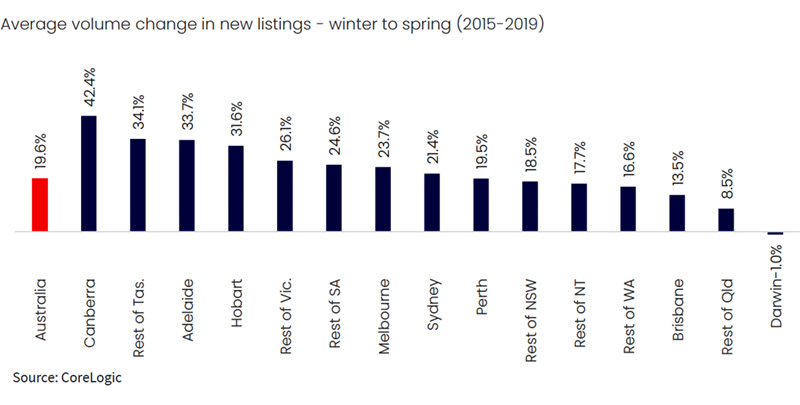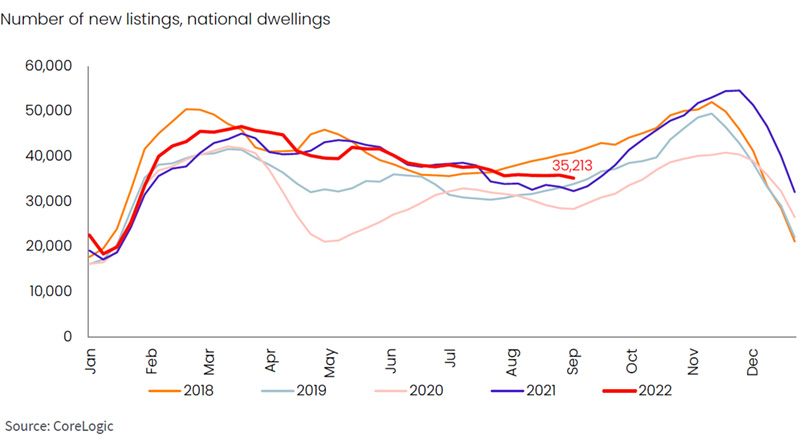Spring selling season set to shape property market's year ahead
How will Australia's spring selling season perform this year, where real estate prices and interest rates are heading in opposite directions, and how will it shape the property market into 2023?
The spring property selling season in Australia traditionally heralds a huge uptick in new listings and buyer activity but this year’s season is shaping as one to watch.
Rapidly rising interest rates, weak consumer sentiment, soaring inflation and persistent affordability issues could suppress this normal post-winter rebound and influence the property market’s momentum for the year ahead.
Unlike previous years, property prices are falling and discounts of up to 10-15 per cent are available.
Buyers Agency Australia founder Dragan Dimovski said interest rates will likely stabilise – or even fall – around the start of February, at which time confidence will return and more buyers will become active, which could see a return of price rises.
“As we enter the spring selling season, which is traditionally busier, we will likely see a rise in listings coming to the market which will see those discounts continue,” he said.
“Buyers also currently have more time to consider their purchases, rather than feeling like they have to rush in.
“But the great buying opportunities we’re seeing now will be limited once interest rates stabilise next year.”
A deluge of new listings is also set add further price pressure to property markets around the country.
Eliza Owen, Head of Research at CoreLogic, said they expected the seasonal lift in new listings was about to take off.
“Despite new listing counts still trending lower, there are some data points that indicate a lift is on its way in the next few weeks.
“The lift in listings is also expected to flow through to the auction market, where the number of properties going under the hammer across the combined capital cities typically lifts from September and continues rising through to the start of December.”

Long-term owner-occupiers are more likely to sell, according to Ms Owen.
“An interesting feature of a housing market in decline is average hold periods of sold properties rise,” Ms Owen said.
“Twelve-month hold periods have been elevated amid the current downturn, as well as the downturn from 2017-2019.”
“This is because recent buyers are at more risk of making a nominal loss if they sell during a downturn.
“Meanwhile, those who have held their property for longer are more likely to have made nominal gains, even if the market is going through a short-term, cyclical downswing.”
As to how the spring selling season would set a trend for the year ahead, Mr Dimovski said more domestic buyers would return to the real estate market next year as sentiment improves, but there would also be an influx of demand from migrants coming back into Australia.
This is particularly due to the Federal Government’s push to increase the skilled migration intake, he said.
“Smart investors never stopped buying during this quieter period in the market, as they know it’s best to act when others are on the sideline, but we will see more homebuyers return to the market in 2022.
“This, along with migration, will significantly boost demand, but we still have a fundamental housing undersupply issue that is not being addressed.
“This will only serve to underpin housing prices moving forward.”
RBA lurking
National home values are sitting just 4.7 per cent higher over the past 12 months, with annual value changes likely to hit negative territory over the course of the cycle.
Clearance rates have been declining over the past year but since May, the clearance rate has hovered around 40 per cent, with the number of total auctions similar to the same period over the past few years, and higher than the past few weeks.
Areas where the biggest uplift in new properties advertised between winter and spring could be expected include Adelaide Hills, where the volume of new listings has previously doubled in this period, and regional lifestyle areas like the Mornington Peninsula, Yass Valley, Surf Coast and Huon Valley.

Tim McKibbin, CEO, Real Estate Institute of NSW, was buoyant about the spring sales season but said the Reserve Bank of Australia was fuelling some uncertainty.
“This spring looks like being characterised by a steady stream of reasonable results for vendors, and opportunities for value for buyers,” he said.
“The Reserve Bank is coming under fire from some quarters as the weight of month-on-month rate increases hits home for many mortgage holders.
“The Governor (Philip Lowe) has been clear on the rationale for the increases but insists that incoming data will guide how much further, and how quickly, rates will need to rise before the RBA deems inflation back under control.
“This uncertainty of the timeline and the magnitude of rate increases fuels uncertainty elsewhere, including in the behaviour of property buyers and sellers.
“It speaks to the resilience of the market that the level of transactional activity remains robust.
“We expect the major indicators to remain stable in the weeks ahead - clearance rates, for instance, are holding firm despite the increase in available stock.”
Ms Owen said 2021 had a particularly ‘bumper’ spring selling season, which is unlikely to be replicated this year.
More listings were likely concentrated at the end of 2021, because rising COVID cases and extended lockdowns across parts of the country would have made it difficult to sell from June to early October.
In other words, sellers were playing ‘catch-up’ as pent-up demand from vendors was unleashed once lockdowns ended. In addition, annual capital growth rates averaged 21.3 per cent nationally through spring last year, creating a big incentive for vendors to ‘cash in’ on price booms.
“Coming into spring 2022, market conditions are very different.
“Buyer appetite is falling against higher interest rates, properties are taking longer to sell, and vendors are having to offer greater price discounts in order to get deals done.”



















